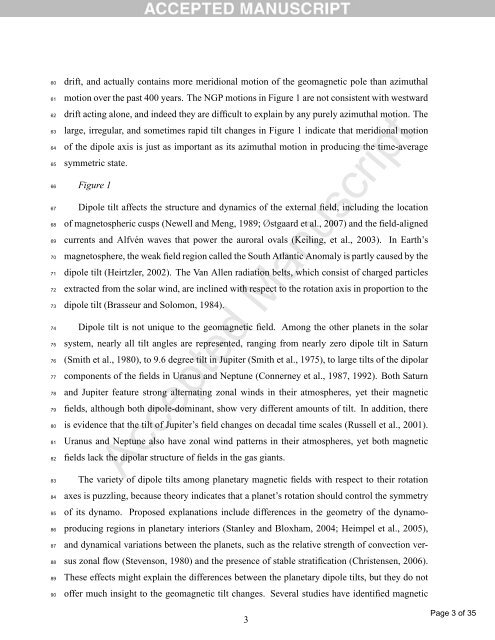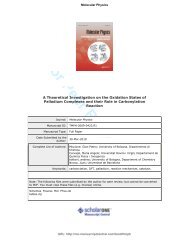Accepted Manuscript - TARA
Accepted Manuscript - TARA
Accepted Manuscript - TARA
Create successful ePaper yourself
Turn your PDF publications into a flip-book with our unique Google optimized e-Paper software.
60<br />
61<br />
62<br />
63<br />
64<br />
65<br />
66<br />
67<br />
68<br />
69<br />
70<br />
71<br />
72<br />
73<br />
74<br />
75<br />
76<br />
77<br />
78<br />
79<br />
80<br />
81<br />
82<br />
83<br />
84<br />
85<br />
86<br />
87<br />
88<br />
89<br />
90<br />
drift, and actually contains more meridional motion of the geomagnetic pole than azimuthal<br />
motion over the past 400 years. The NGP motions in Figure 1 are not consistent with westward<br />
drift acting alone, and indeed they are difficult to explain by any purely azimuthal motion. The<br />
large, irregular, and sometimes rapid tilt changes in Figure 1 indicate that meridional motion<br />
of the dipole axis is just as important as its azimuthal motion in producing the time-average<br />
symmetric state.<br />
Figure 1<br />
Dipole tilt affects the structure and dynamics of the external field, including the location<br />
of magnetospheric cusps (Newell and Meng, 1989; Østgaard et al., 2007) and the field-aligned<br />
currents and Alfvén waves that power the auroral ovals (Keiling, et al., 2003). In Earth’s<br />
magnetosphere, the weak field region called the South Atlantic Anomaly is partly caused by the<br />
dipole tilt (Heirtzler, 2002). The Van Allen radiation belts, which consist of charged particles<br />
extracted from the solar wind, are inclined with respect to the rotation axis in proportion to the<br />
dipole tilt (Brasseur and Solomon, 1984).<br />
Dipole tilt is not unique to the geomagnetic field. Among the other planets in the solar<br />
system, nearly all tilt angles are represented, ranging from nearly zero dipole tilt in Saturn<br />
(Smith et al., 1980), to 9.6 degree tilt in Jupiter (Smith et al., 1975), to large tilts of the dipolar<br />
components of the fields in Uranus and Neptune (Connerney et al., 1987, 1992). Both Saturn<br />
and Jupiter feature strong alternating zonal winds in their atmospheres, yet their magnetic<br />
fields, although both dipole-dominant, show very different amounts of tilt. In addition, there<br />
is evidence that the tilt of Jupiter’s field changes on decadal time scales (Russell et al., 2001).<br />
Uranus and Neptune also have zonal wind patterns in their atmospheres, yet both magnetic<br />
fields lack the dipolar structure of fields in the gas giants.<br />
The variety of dipole tilts among planetary magnetic fields with respect to their rotation<br />
axes is puzzling, because theory indicates that a planet’s rotation should control the symmetry<br />
of its dynamo. Proposed explanations include differences in the geometry of the dynamoproducing<br />
regions in planetary interiors (Stanley and Bloxham, 2004; Heimpel et al., 2005),<br />
and dynamical variations between the planets, such as the relative strength of convection versus<br />
zonal flow (Stevenson, 1980) and the presence of stable stratification (Christensen, 2006).<br />
These effects might explain the differences between the planetary dipole tilts, but they do not<br />
offer much insight to the geomagnetic tilt changes. Several studies have identified magnetic<br />
<strong>Accepted</strong> <strong>Manuscript</strong><br />
3<br />
Page 3 of 35
















